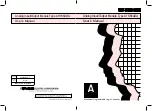
Page 3 - 21
TL49J
SERVICE AND REPAIR
ERROR CODES
I
f the display panel on the box is flickering between -1 and 2, then there is a fault in the transformer or
the black box. Check the two output fuses under the terminal cover. The black box or the transformer
contains no user replaceable parts. Opening the black box apart from the terminal cover shown will
invalidate the warranty.
If the “time out light” comes on, there is a possibility of a faulty battery. Check each cell with a hydrometer.
The “time out light” will come on and the charger will switch off if gassing level has not been reached in
24 hours. The “reverse polarity light” will light if the output cables to the battery are reversed. The red
cable must go to the positive terminal and the black cable goes to the negative terminal.
CHARGING TIMES
The charger will recharge 2/3’s of discharged batteries in 8 to 10 hours. In reality, batteries are often
discharged more than 2/3’s when used on an access platform. The operator tends to use the machine
until the motor stops (This causes arcing of the motor contactor and severe heat rise in the motor; both
of which shortens the components life considerably.). After which it is easy to forget to put the machine
back on charge after using it. This results in the battery being as much as 95% discharged before the
charger is connected (this causes severe reduction in battery life).
If the battery cell voltage is below 1 V, the charger may not start. In this case, hold down the low volt-
age start button for several seconds. This will bypass the charger safety system and cause it to start
irrespective of battery voltage. After the voltage has increased sufficiently for the controller to take over,
the button can be let go off.
If gassing level is not reached in 24 hours, the charger will switch off and the “time out light” will come
on. Disconnecting the input lead will automatically re-set the timer. Take care not to disconnect the
charger during a charging cycle. Always let the charger reach “Charge complete” or “Time out” to pre-
vent overcharging.
PRACTICAL APPLICATIONS
The machine will not work if the batteries are run down fully. This is still the case even if the charger is
connected. The electric motor requires as much as 3 times the charger output. The charger will float
on 30 A maximum and the motor will not turn (This results in damage to the motor and contactor). If the
user has a very hectic work schedule, it is easy to run out of battery power before work is completed. In
this case, the charger can be connected to the mains supply before the batteries are 50% discharged.
This will provide enough time for the charger to keep topping up the batteries and extend the duty cycle
of the machine considerably. The battery life may be slightly reduced as the optimum charging cycle
for any battery is “fully charged - 2/3’s discharged and then fully charged.
To check if a charger works, connect the voltmeter to the same battery terminals as the charger. Take
a note of the reading. The next step is to connect the charger to a mains voltage. There should be a
marked increase in voltage. Check the display on the charger. An in-line anmeter (or use a clamp on
type) can also be connected to check that the charger output display matches the current going into
the batteries.
BATTERY & CHARGING CHECKLIST
•
Check that the fuses are secured in the fuse holder.
•
Check that all wires are secure on the terminal block and on the battery terminal.
•
Check that the multi pin plug is secure on the pcb.
•
Check for damage to cables and wiring.
BATTERY SAFETY PRECAUTION
W
hen charging the battery, explosive hydrogen gas will be given off. Keep away from open flames.
Always wear appropriate personal safety equipment such as eye goggles and rubber gloves to prevent
injury incase of spillage. Keep the top of the batteries clean and free from dirt. It is very easy for the
battery to be contaminated when topping up with distilled water. Regular topping up with distilled water
will be required from time to time.
















































